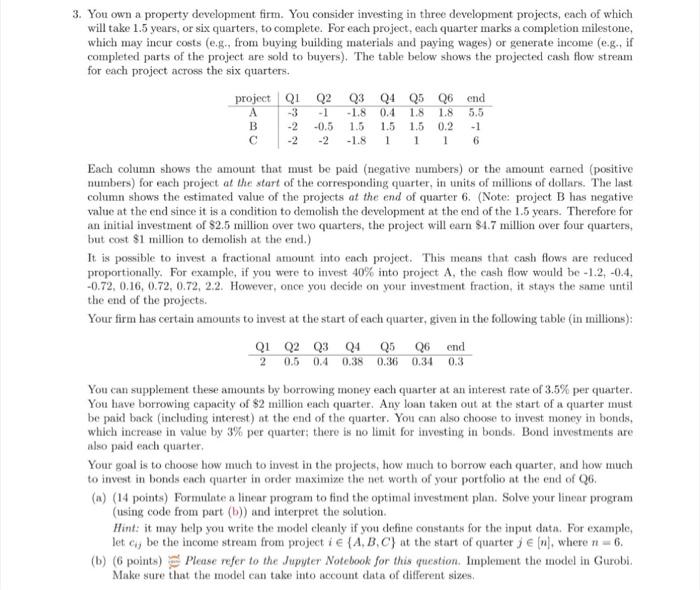3. You own a property development firm. You consider investing in three development projects, each of which will take 1.5 years, or six quarters, to complete. For each project, each quarter marks a completion milestone, which may incur costs (e.g., from buying building materials and paying wages) or generate income (e.g., if completed parts of the project are sold to buyers). The table below shows the projected cash flow stream for each project across the six quarters. Each column shows the amount that must be paid (negative numbers) or the amount earned (positive numbers) for each project at the start of the corresponding quarter, in units of millions of dollars. The last column shows the estimated value of the projects at the end of quarter 6. (Note: project B has negative value at the end since it is a condition to demolish the development at the end of the 1.5 years. Therefore for an initial investment of $2.5 million over two quarters, the project will earn $4.7 million over four quarters, but cost $1 million to demolish at the end.) It is possible to invest a fractional amount into each project. This means that cash flows are reduced proportionally. For example, if you were to invest 40% into project A, the cash flow would be 1.2,0.4, 0.72,0.16,0.72,0.72,2.2. However, once you decide on your investment fraction, it stays the same until the end of the projects. Your firm has certain amounts to invest at the start of each quarter, given in the following table (in millions): You can supplement these amounts by borrowing money each quarter at an interest rate of 3.5% per quarter. You have borrowing capacity of $2 million each quarter. Any loan taken out at the start of a quarter must be paid back (including interest) at the end of the quarter. You can also choose to invest money in bonds. which inerease in value by 3% per quarter; there is no limit for investing in bonds. Bond investments are also paid each quarter. Your goal is to choose how much to invest in the projects, how much to borrow each quarter, and how much to invest in bonds each quarter in order maximize the net worth of your portfolio at the end of Q6. (a) (14 points) Formulate a linear program to find the optimal investment plan. Solve your linear program (using code from part (b)) and interpret the solution. Hint: it may belp you write the model cleanly if you define constants for the input data. For example, let cij be the income stream from project i{A,B,C} at the start of quarter j[n], where n=6. (b) (6 points) Please refer to the Jupyter Notebook for this question. Implement the model in Gurobi. Make sure that the model can take into account data of different sizes







